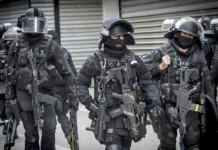9-Hole ran their practical accuracy test on the Tabuk (or rather a Tabuk-a-like) to see if the rather famous/infamous rifle the Iraqi armed forces shoehorned into the DMR role was actually worth a shake.
The Tabuk is an interesting animal
9-Hole put this under the video:
The Iraqi Tabuk Sniper rifle is based on the famous Yugoslavian M70 type Kalashnikov rifles. Boasting a 23in barrel and manufactured on Yugoslavian/Serbian tooling, in Al-Qadisiya, Iraq.
This specific reproduction rifle was made by Two Rivers Arms in Oklahoma.
While many see this as a way of extending the 7.62×39 cartridge’s distance, the rifle was categorized to only have a max effective range of 600m. However the rifle has lived on to be an effective “urban sniper” weapon or a platoon-level marksman’s rifle, as the marksman is able to interchange and cross-land ammunition/magazines with infantry regulars. This directly solves many logistical issues that a large standing army with lesser logistical support may face.
Fast forward into the 90’s and 2000’s, US forces entering Iraq now face the Tabuk Sniper as a rifle encountered in the hands of both insurgents and friendly troops from the region.
The Tabul was a simple and inelegant solution to the DMR question for Iraq. They needed a rifle in the role, they used AK’s. Put an RPK type barreled AK in and put an optic on it. Done.
While nobody is accusing the stubby slow 7.62×39 of exceptional accuracy, it isn’t an inaccurate round. It simply has a lower BC (Ballistic Coefficient) than much of the western nations standardize on when it comes to precision kinect munitions. Iraq wasn’t looking for a high BC, they needed a rifle that supported their squads.
Their squads are running AK’s, generally slick down. No optics, lights, sometimes slings. A 4x equipped optic that’s coaxing a little more speed on front end can put a little more legs on the round, but the real benefit is in the optic. Observing the target and putting accurate rounds or guiding accurate rounds from the squad onto target is where the Tabuk needed to do work.
It’s the same theory of slapping a variable power on an M16A2 or A4 and calling it a DMR, changing the optic alone can up the hit percentages by granting a better target picture. No other change is immediately necessary for the rifle to support the squad.



